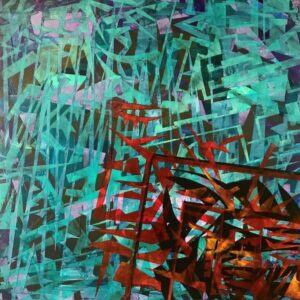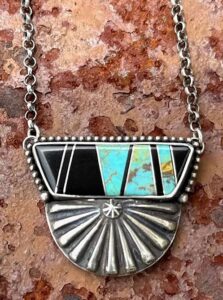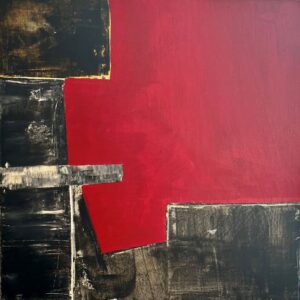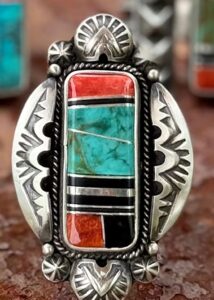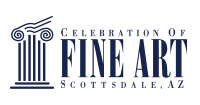Creating artwork is a journey. At least, that’s how artist Robert Redus sees it. Every piece follows an arc of evolution––going through complex and dynamic changes. Like most living things, artwork often unfolds over a somewhat diametric journey filled with harmony and conflict, peaks of success and troughs of failure––growing into what it is meant to become along the way.
Incidentally, Robert also sees this journey mirrored in his life as a professional artist. Though he’s always been drawn to creative endeavors, he didn’t grow up in a household that prioritized art. And a career as a professional artist was certainly never viewed as a viable option for him.
Still, as he progressed into adulthood, that passion for art and making never faded. And it was a fateful visit to the San Francisco Museum of Modern Art that suddenly moved him to take action. Upon returning to his hometown in New Mexico, he immediately enrolled in the fine arts program at the local university. That decision ignited something in him––he committed to painting and learning as much as he could about it and he never looked back.
In this interview, Robert shares the journey that led him to art and how his work has evolved.
Q&A with Robert
What inspired you to pursue art as a career?
I have always been inspired by creative endeavors––those that require an aesthetic solution that answers the questions. I’ve been a maker/creative my entire life and have always leaned toward the beauty in just about everything.
The turning point for me that changed my trajectory and forced the art commitment was going to an art show at SFMOMA (San Francisco Museum of Modern Art). The artists were Richard Diebenkorn and Alexander Calder, and I was so moved by both of their works that I wanted to be able to move people and inspire people through my work, which, at the time, was as a jeweler. I returned to New Mexico and enrolled at the university to pursue a degree in fine art with an emphasis on studio painting. The very best decision I’ve made.
How did you get your start creating art?
I’ve always made things, so the path to this creative place was always there, it just took the better part of my life to accept that. I came from a very conservative military family where art was not a priority nor a blip on the professional career list of possibilities.
At 47, I returned to the University of New Mexico and committed to painting and learning as much as I could about the process of painting. The contacts and relationships with professors––who were in most cases my age––allowed me to integrate into their world as more than just a student. I developed friendships with them and they mentored me.
What do you find most rewarding about your work?
I love the process of painting, while the end result matters little. The journey of the work, its evolution and changes, is always rewarding and a true pleasure.
The relationship I have with the painting is also a wonderful dynamic. A painting develops a life––a personality that is great, yet also brings conflict and dispute to the process. And in a way, that diametric opposition is a reflection of the life I live as an artist.
What is the most challenging?
There are many challenges that arise as a painter––defining
what is working and how to accept that it’s not always going to be working. Painting to me is a process of small successes and small failures that build on each other. Much like the view of a mountain range, a painting builds success and at some point begins to decline only to start the success ascent again. My challenges are remaining risky, exercising restraint, listening to the painting, and trusting my intuition.
How has your work evolved over the years?
Painting is synonymous with developing a unique voice. The creative skills can be there, yet they need to be honed and developed to match the voice that is beginning to emerge. To me, every painting I paint is a self portrait, and I am by no means who I was 20 years ago. Style develops. It morphs and evolves as I do and have.
My original work was influenced by a great painting mentor of mine. He developed a process of painting that was non-linear, non-referential and process oriented. That being said, I painted chaos. I painted how wildebeest ran across the savannah, how flocks of birds flew, and schools of fish swam. I call it “Controlled Chaos” for lack of better words. Risk and bravery changed that game. Incorporating risk and bravery into the process, by definition, pushes boundaries and creates different vantage points to work from. Small shifts, if allowed, create larger shifts and once changes begin, it becomes impossible to stop that momentum. Going back to what once was does not exist. Movement and exploration create new shifts in the work. Throw in some risk, bravery and restraint, and things begin to get juicy.
Is there a particular piece you’re excited to introduce at the Celebration of Fine Art?
I am very excited about the new work I’m doing. It is a refinement of a long journey in painting. They are birch panels, 4 and 6 inches wide by 12 inches, 24 inches, 36 inches and 60 inches long. They are about fit and how everything in our world requires everything else in our world in order to exist.
These paintings are from an outlier mindset that defies the traditional 24 x 48 canvas that fits perfectly over the couch. My current paintings are more for those obscure, sacred, small spaces that are the hidden niches in people’s homes. I’m very excited to show these works and work on new ones while at the Celebration.
What drew you to the Celebration of Fine Art?
I visited the Celebration a couple of years ago while on a trip through Scottsdale and was not only blown away by the work but very impressed by the entire concept. Seeing the talent and the vibe of the space, I knew I wanted to be a part of this. I am honored and blessed to be a participant and and very excited about showing both my paintings and jewelry.
